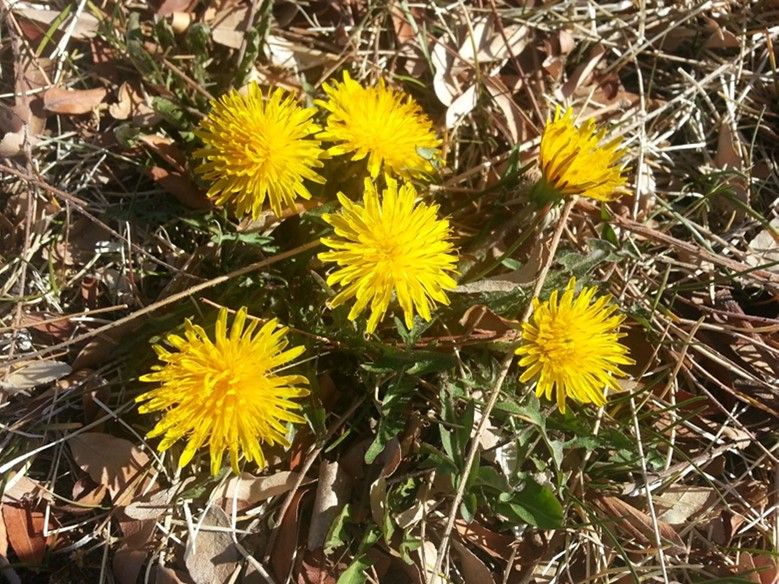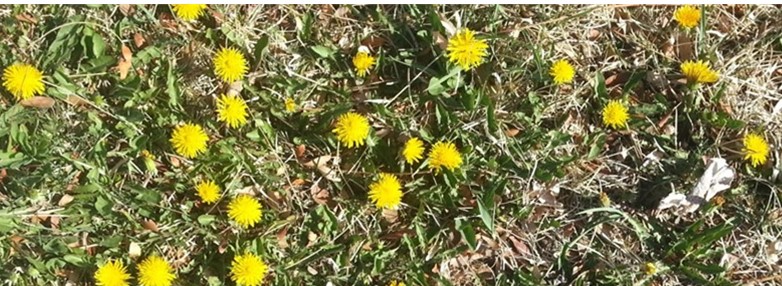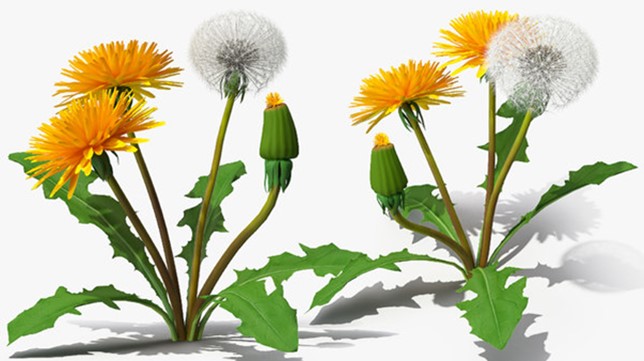
Figure 1: Dandelion flowers in full bloom.
Caution: Always positively identify a plant before consuming. Sickness or death may occur from eating the wrong plant. Use a good reference book or website for identification such as Plant for a Future (www.pfaf.org) or (www.EatTheWeeds.com).
“Dandy” used to be a common term to describe a man who placed particular importance on his appearance, style of clothes, impeccable sense of fashion, highly educated manner of speech, and trendy choice of avocations, all of which served to show off his refinement and good taste. Dandelions, on the other hand, place their greatest emphasis solely on good taste, although a lawn full of their showy spring blooms also represents the highest sense in fashion.
One can’t deny that dandelion is a beautiful weed, but most people don’t realize that it is also a harbinger of healthy lawns, and that dandelion supplies a plethora of tasty, nutritious and highly medicinal products. The name of dandelion comes from the French term, “dent de lion,” which means “lion’s tooth,” referring to the toothy shape of the leaves. The genus and species name of dandelion is Taraxacum officinale and is believed to come from an ancient Persian term talkh chakok, which translates to “bitter herb,” while the officinale portion of the name refers to it being a medicinal herb that was once listed in official European pharmacopeias.
According to WebMD, dandelion root tea contains polysaccharides known to relieve stress on one’s liver by helping it produce greater quantities of bile to filter out harmful chemicals in the foods we eat. Dandelion greens are rich in Vitamin A, B6, C, D calcium, copper, and potassium. The roots are rich in inulin, which helps to promote healthy probiotics in the gut. Dandelion leaf or root tea is powerfully diuretic, so restraint is in order by those on blood pressure medicines or other blood thinners. This tea is not highly recommended to use just before going to bed. The French refer to it as pissenlit, which basically means “bed wetter.” While dandelion is the favored “go to” wild herb by many wild food foragers, it is also equally the “I need to go” herb as well.

Figure 2: A field of Dandelions.
Having never eaten dandelion greens, on April 2nd, I collected three cups of dandelion leaves, which I boiled and served with butter, balsamic and a sprinkling of salt. It was one of my favorite greens ever. This might even beat lambsquarters for its flavor and delicate texture and taste. At the time, I did taste some fresh young dandelion leaves raw, and was quite surprised at the initial sweetness of the greens; and the bitterness that I expected was drastically less than I expected.
In his classic work, Stalking the Healthful Herbs, Euell Gibbons describes using the leaves as a source of greens, and using the crown and unopened blossoms as a succulent vegetable. He also used the young taproots in a manner similar to parsnip, or slowly roasted older, more bitter roots to form an excellent coffee substitute. When roasting the roots, they emit a smell of honey and coffee. Lastly, he describes using the open blossoms as the prime flavoring for wine. Something that isn’t common knowledge is that the ancient Egyptians first used dandelion to brew beer and flavor wine. While the practice of making dandelion beer has been lost, a quick internet search will show that dandelion wine is still popular.
On April 7th, I tasted a few dandelion blossoms for the first time and found they were excellent! There is a definite sweetness with a fragrance a little like newly mown alfalfa and sweet grass. On their own, the flowers aren’t really bitter but there is a slight green taste at the base, however, the flavor of the petals is similar to apricot. Their incredible yellow color signifies that those golden rays are bursting with beta-carotene.
My favorite use of dandelion blossoms is to produce a vegan honey. While I’m an ardent omnivore and former beekeeper; nevertheless, I wholeheartedly agree that dandelion flowers make a “honey” that is in some ways equal in flavor, and possibly superior in nutrition to bee-made honey (sans the protein from the pollen in real honey). My recipe for dandelion honey is made with the following amounts of ingredients:
- 2 cups packed fresh dandelion flower petals
- 2 tsp. fresh lemon or orange zest (not the juice)
- 1-3/4 cups water
- 1-1/2 cups raw sugar
- 1/8 tsp. vanilla extract.
Using the above ingredients, simply follow this 12-step preparation and cooking process:
- Pick dandelion flowers in full bloom early in the day while full of nectar.
- Put the flowers in cold water and allow to soak for five minutes to remove any insects.
- Snip off the petals with kitchen shears. Use only the petals for these measurements. Toss away the green parts of the flower (center and stem).
- Put the dandelion petals and citrus zest in a heavy saucepan, and pour in the water.
- Bring gently to a boil, then reduce the heat, and allow it to simmer for 30 minutes. Following that time, remove the pan from the heat, and let the dandelion tea steep for 6 hours.
- Strain the dandelion tea through a colander, strainer or cheesecloth, and discard the plant parts.
- Place the dandelion flower tea back into a heavy saucepan and bring it to a simmer.
- Gradually add sugar to the simmering liquid while stirring until the sugar is dissolved.
- Lower the heat and let it continue to simmer uncovered until it reaches the desired viscosity (gets thick and syrupy). This may take up to an hour. Check for viscosity by placing a metal spoon into the syrup and then let it cool on a plate. If it gets too thick, it will start to caramelize and will later crystallize.
- Stir in the vanilla extract.
- Immediately afterwards, pour the syrup into sterilized jars and put the lid on while hot.
- Store in a cool dark place, or if the dandelion honey is fairly thin, store in the refrigerator.

Figure 3: The three stages of the dandelion flower.
Gardeners who mistakenly think of dandelions as an enemy should know they improve soil quality. Once the green crown dies off, the root decomposes, adding food to healthy soil microorganisms, as well as new organic material. They also aerate the soil by leaving holes where the roots once grew. While the roots are alive, they break apart hard soils, plus they act as a bioaccumulator to bring up nutrients from deep in the ground where grassroots couldn’t otherwise reach. On an interesting side note, dandelions release ethylene gas, which means that if they are allowed to grow near fruiting annuals or perennials, they may help to speed up the ripening of fruit, including tomatoes. Dandelion’s beautiful golden flowers also serve to attract beneficial insects.
More on ethylene gas (C2H4 or H2C=CH2): It is exhaled by the leaves and flowers of dandelion. Ethylene gas signals to fruiting bushes and trees that it’s time for them to ripen their fruit now, which is what corporate ag does to create as much of a uniform harvest (time wise) as possible when it comes to getting fruit products to ripen around the same time, such as tomatoes. Ethylene gas does have some downsides in that you would not want to have other types of greens in the refrigerator next to dandelion greens, since ripening greens (and most vegetables) means rotten greens and vegetables. Ethylene gas also has another purpose in the plant world, which is to decrease competition around it, which is why you don’t see a lot of other different kinds of weeds growing next to dandelions. While that is an advantage of dandelions in lawns, it also seems to inhibit the growth of other broadleaf plants in general, since they prefer not to breathe in ethylene gas.
What about the use of herbicides? Gardening research shows that most herbicides are designed to be delivered in a volatile medium, so that the worst of the toxin evaporates between 24 to 78 hours. Moreover, Federal regulations require most herbicides (especially those used by homeowners) to break down in soils within 14 days. Therefore, it should be safe for anyone to spray for broadleaf weeds in their lawns and then collect the surviving edible weed products any time after two weeks to be on the safe side.
For Southern Nevada Gardening Information and Help: Contact the Master Gardener Help Desk via telephone. Open Monday through Friday from 9 a.m. to 3 p.m. except holidays at 702-257-5556 or by email at (Extension-ClarkMG@unr.edu). Walk-ins welcomed.


